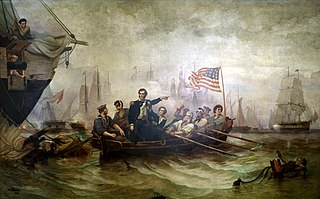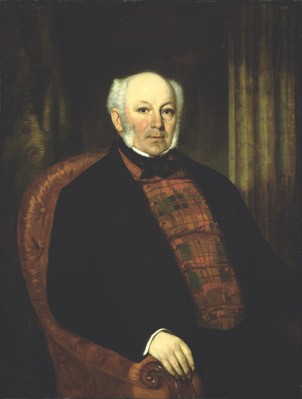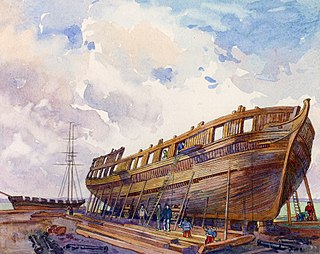
John Graves Simcoe was a British Army general and the first lieutenant governor of Upper Canada from 1791 until 1796 in southern Ontario and the watersheds of Georgian Bay and Lake Superior. He founded York, which is now known as Toronto, and was instrumental in introducing institutions such as courts of law, trial by jury, English common law, freehold land tenure, and also in the abolition of slavery in Upper Canada.

The Province of Upper Canada was a part of British Canada established in 1791 by the Kingdom of Great Britain, to govern the central third of the lands in British North America, formerly part of the Province of Quebec since 1763. Upper Canada included all of modern-day Southern Ontario and all those areas of Northern Ontario in the Pays d'en Haut which had formed part of New France, essentially the watersheds of the Ottawa River or Lakes Huron and Superior, excluding any lands within the watershed of Hudson Bay. The "upper" prefix in the name reflects its geographic position along the Great Lakes, mostly above the headwaters of the Saint Lawrence River, contrasted with Lower Canada to the northeast.

Niagara-on-the-Lake is a town in Ontario, Canada. It is located on the Niagara Peninsula at the point where the Niagara River meets Lake Ontario, across the river from New York, United States. Niagara-on-the-Lake is in the Niagara Region of Ontario and is the only town in Canada that has a lord mayor. It had a population of 19,088 as of the 2021 Canadian census.
The Battle of York was a War of 1812 battle fought in York, Upper Canada on April 27, 1813. An American force, supported by a naval flotilla, landed on the western lakeshore and captured the provincial capital after defeating an outnumbered force of regulars, militia and Ojibwe natives under the command of Major General Roger Hale Sheaffe, the Lieutenant Governor of Upper Canada.

The Battle of Lake Erie, also known as the Battle of Put-in-Bay, was fought on 10 September 1813, on Lake Erie off the shore of Ohio during the War of 1812. Nine vessels of the United States Navy defeated and captured six vessels of the British Royal Navy. This ensured American control of the lake for the rest of the war, which in turn allowed the Americans to recover Detroit and win the Battle of the Thames to break the Indian confederation of Tecumseh. It was one of the largest naval battles of the War of 1812.

The Welland Canal is a ship canal in Ontario, Canada, and part of the St. Lawrence Seaway and Great Lakes Waterway. The canal traverses the Niagara Peninsula between Port Weller on Lake Ontario, and Port Colborne on Lake Erie, and was erected because the Niagara River—the only natural waterway connecting the lakes—was unnavigable due to Niagara Falls. The Welland Canal enables ships to ascend and descend the Niagara Escarpment, and has followed four different routes since it opened.

Sir Allan Napier MacNab, 1st Baronet was a Canadian political leader, land speculator and property investor, lawyer, soldier, and militia commander who served in the Legislative Assembly of Upper Canada twice, the Legislative Assembly for the Province of Canada once, and served as joint Premier of the Province of Canada from 1854 to 1856. MacNab was "likely the largest land speculator in Upper Canada during his time" as mentioned both in his official biography in retrospect and in 1842 by Sir Charles Bagot.

Canada Steamship Lines (CSL) is a shipping company with headquarters in Montreal, Quebec, Canada. The business has been operating for well over a century and a half.
USS Julia was a schooner in the United States Navy during the War of 1812. Initially the privately-owned schooner Julia, she was captured at the onset of the war by armed boats looking for violators of President James Madison's embargo of trade with the British. Purchased by the United States Navy, the vessel was armed with two guns and made part of the squadron on Lake Ontario. Julia took part in the Battle of York and the Battle of Fort George. In August 1813, the schooner was captured by the Royal Navy after failing to execute a turn and was put in service as HMS Confiance. The vessel continued as a warship in British service for a couple of weeks before being converted to a troop transport. In October, Confiance was recaptured by the Americans and renamed Julia. No longer considered capable as a warship, the vessel was retired from service.

HMS Royal George was a British 20-gun wooden sloop of the Provincial Marine, and subsequently, the Royal Navy, operating on Lake Ontario during the War of 1812. The vessel took part in several Engagements on Lake Ontario and was the flagship of the Provincial Marine at the First Battle of Sackett's Harbor. In 1814, the vessel was renamed Niagara. Following the war, the sloop was converted to a transport and sold in 1837.

HMS St Lawrence was a 102-gun first-rate wooden warship of the Royal Navy that served on Lake Ontario during the War of 1812. Built on the lake at the Royal Navy dockyard in Kingston, Ontario, she was the only Royal Navy ship of the line ever to be launched and operated entirely in fresh water. Constructed in 1814, the ship's arrival on the lake ended all naval action and St Lawrence finished the war having never gone into battle. Following the war, the vessel was laid up, eventually being sold in 1832 to private interests. The ship later sank and is now a recreational dive spot.
Toronto was a schooner of the Provincial Marine, built by John Dennis on the Humber River at York (Toronto), Upper Canada that entered service in 1799 on the Great Lakes. The ship was built to ferry government officials from York to Upper Canada's former capital of Newark. The ship's career was short; she was wrecked in 1811 off Hanlan's Point and was broken up.

The Engagements on Lake Ontario encompass the prolonged naval contest for control of the lake during the War of 1812. Few actions were fought, none of which had decisive results. The contest essentially became a naval building race, sometimes referred to sarcastically as the "Battle of the Carpenters."

The Kingston Royal Naval Dockyard was a Royal Navy Dockyard from 1788 to 1853 in Kingston, Ontario, Canada, at the site of the current Royal Military College of Canada.

The Naval Shipyards were naval shipbuilding facilities used by the Provincial Marine and the Royal Navy in York, Upper Canada. The naval shipyards were ordered by the Lieutenant Governor of Upper Canada John Graves Simcoe in 1793, and were opened in 1798.

Provincial Marine was a coastal protection service in charge of the waters in the Great Lakes, the St. Lawrence River and parts of Lake Champlain under British control. While ships of the Provincial Marine were designated HMS, they were operated in more of a coast guard manner than as a full-fledged navy. Most ships of the Provincial Marine were built on the Great Lakes.

The history of commercial passenger shipping on the Great Lakes is long but uneven. It reached its zenith between the mid-19th century and the 1950s. As early as 1844, palace steamers carried passengers and cargo around the Great Lakes. By 1900, fleets of relatively luxurious passenger steamers plied the waters of the lower lakes, especially the major industrial centres of Chicago, Milwaukee, Detroit, Cleveland, Buffalo, and Toronto.
Thomas Davies FRS FLS was a British Army officer, artist, and naturalist.

SS Manasoo was a steel-hulled Canadian passenger and package freighter in service between 1888 and 1928. She was built in 1888 in Port Glasgow, Scotland, by William Hamilton & Company for the Hamilton Steamboat Company of Hamilton, Ontario, who used her as a passenger transport between Hamilton and Toronto, Ontario. Macassa was lengthened in Collingwood, Ontario, in 1905. She was sold twice before being sold to the Owen Sound Transportation Company, Ltd., and was rebuilt and renamed Manasoo; after the sale, she mainly operated between Sault Ste. Marie and Owen Sound, Ontario.















